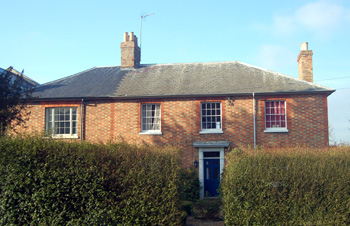
17 High Street January 2011
Volume 81 published by Bedfordshire Historical Records Society (2002) is a series of episcopal visitations undertaken in the first twenty years of the 18th century, edited by former County Archivist Patricia Bell. At each visitation a list of questions was sent out in advance, one of which enquired about the provision of schools in each parish. In 1709 the curate wrote: "No public or charity Schole [sic]". In 1717 he wrote: "There is no Publick [sic] or charity School endowed or maintained. There is a Widow woman teaches some few children to read, which are all that any ways are taught in the Parish". In 1720 the curate wrote: "There is no Publick or Charity School endow'd or otherwise maintain'd in my Parish, but Parents take care to instruct their Children in the principles of the Christian Religion by sending 'em to Adjacent Schools".
In 1818 a Select Committee was established to enquire into educational provision for the poor. This was no doubt prompted, in part, by the recent foundation of two societies promoting education and specifically the building of schools. The Society for Promoting the Lancasterian System for the Education of the Poor was established in 1808 promoting schools run along the lines pioneered by Joseph Lancaster, who had himself copied those of Dr. Andrew Bell, in which older children taught their younger fellows. The Society was renamed the British and Foreign School Society in 1814. It was supported by a number of prominent nonconformists, Lancaster himself was a Quaker, and sought to teach a non-sectarian curriculum. In answer to this perceived nonconformist takeover of local education the National Society was firmed in 1811 to encourage the teaching of poor children along Anglican lines, including the catechism. The Select Committee sent a questionnaire to all parishes in the country asking for: particulars relating to endowments for the education of children; other educational institutions; observations of parish needs etc. For Ridgmont it was recorded that there was a Church of England Sunday school supported by voluntary contributions which taught 15 boys and 5 girls; there was also a Dissenters' Sunday school which took 122 boys and 17 girls. This would have been a school run by the Baptists which met at 17 High Street. A boarding school was kept by a dissenter but not attended by the poorer classes. The Rector, Edward Tanqueray recorded that "the poor are very desirous of the means of education". It is worth noting that these Sunday schools were just that, School provided on a Sunday and would have taught reading and writing and, perhaps, other subjects, in addition to the religious knowledge for which Sunday schools are reserved today.
In the country generally the number of schools built continued to grow over the next fifteen years so that by 1833 the government agreed to supplement the work of the two societies, and local benefactors, by making £20,000 per annum available in grants to help build schools. It also prompted another questionnaire to be sent to each parish in England asking for details of local educational provision. For Ridgmont it was recorded that there was one Daily School (started in1831) which taught 33 boys and 10 girls whose parents paid for their lessons. There were now two Sunday schools – one, the Anglican, begun in 1833 and supported by the clergyman, took 28 boys and 22 girls; the other taught 80 boys, and 115 girls and was supported by subscription from the Baptists and had a lending library attached; evidence [X347/2] suggests this began in 1816. The nature of the daily school, whether Anglican, nonconformist or neither, is unclear but it may be an early reference to the Wesleyan School.
The next national enquiry was in 1846/7 when the Church of England made an enquiry as to all its church schools. This was against the background of a new Whig government which championed secular education and the increasing importance of nonconformists, particularly Wesleyan Methodist, and Roman Catholics in providing schools. The return states that the church ran a Sunday school and a Daily School which taught 30 boys and 22 girls. A rural deanery proforma parish survey of 1848 [AB/RD/A0] states: "Day School of about 30 children taught in a miserable low room". It also noted: "There area great many Baptists & Wesleyans, who have good Schools".